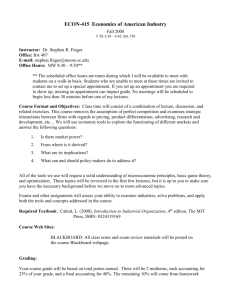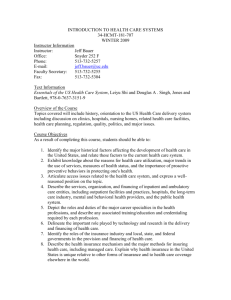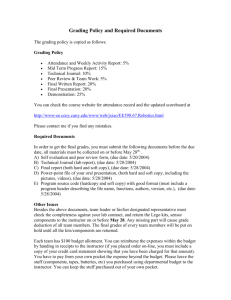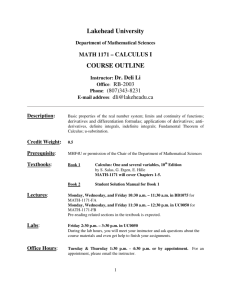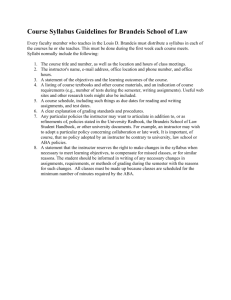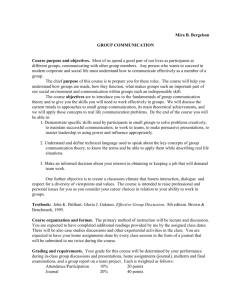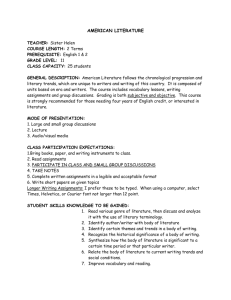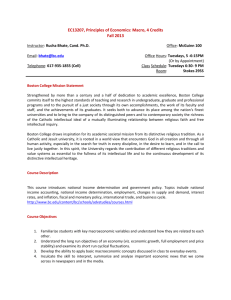EMGT5330-SOM Mini-Syllabus - University of Houston
advertisement
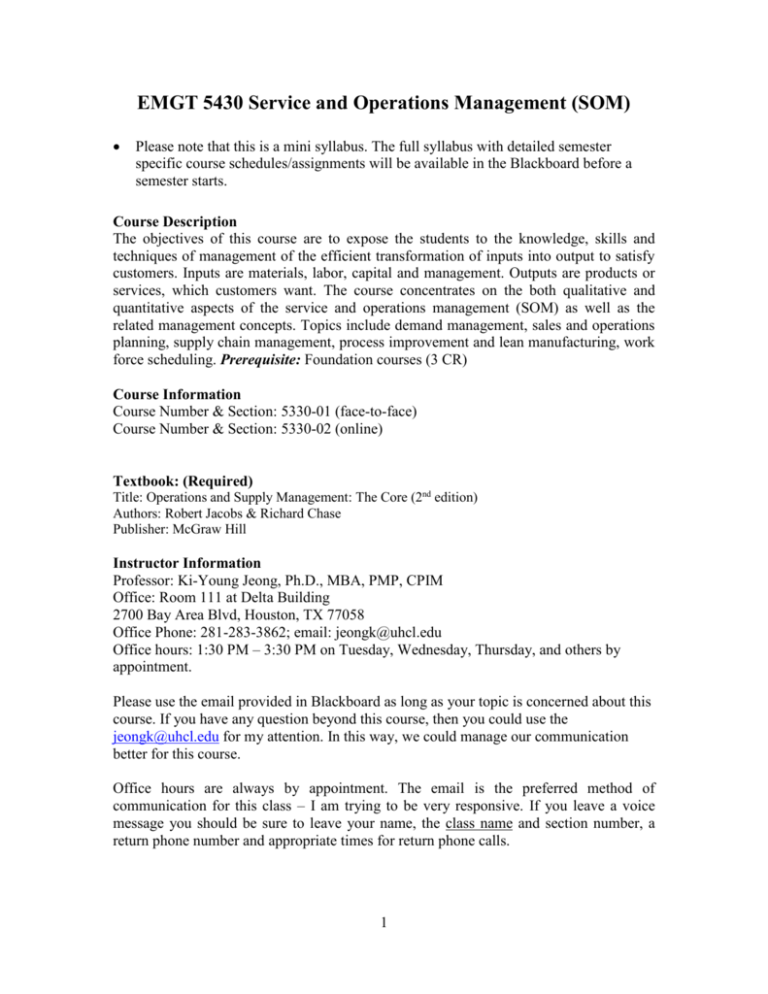
EMGT 5430 Service and Operations Management (SOM) Please note that this is a mini syllabus. The full syllabus with detailed semester specific course schedules/assignments will be available in the Blackboard before a semester starts. Course Description The objectives of this course are to expose the students to the knowledge, skills and techniques of management of the efficient transformation of inputs into output to satisfy customers. Inputs are materials, labor, capital and management. Outputs are products or services, which customers want. The course concentrates on the both qualitative and quantitative aspects of the service and operations management (SOM) as well as the related management concepts. Topics include demand management, sales and operations planning, supply chain management, process improvement and lean manufacturing, work force scheduling. Prerequisite: Foundation courses (3 CR) Course Information Course Number & Section: 5330-01 (face-to-face) Course Number & Section: 5330-02 (online) Textbook: (Required) Title: Operations and Supply Management: The Core (2nd edition) Authors: Robert Jacobs & Richard Chase Publisher: McGraw Hill Instructor Information Professor: Ki-Young Jeong, Ph.D., MBA, PMP, CPIM Office: Room 111 at Delta Building 2700 Bay Area Blvd, Houston, TX 77058 Office Phone: 281-283-3862; email: jeongk@uhcl.edu Office hours: 1:30 PM – 3:30 PM on Tuesday, Wednesday, Thursday, and others by appointment. Please use the email provided in Blackboard as long as your topic is concerned about this course. If you have any question beyond this course, then you could use the jeongk@uhcl.edu for my attention. In this way, we could manage our communication better for this course. Office hours are always by appointment. The email is the preferred method of communication for this class – I am trying to be very responsive. If you leave a voice message you should be sure to leave your name, the class name and section number, a return phone number and appropriate times for return phone calls. 1 Course Objectives Major Learning Outcomes: The student will demonstrate an understanding of demand management and its techniques and relations with sales and operations planning. The student will demonstrate an understanding of quantitative techniques and tools such as Linear Programming and Integer Programming and their role in SOM as decision-support systems. The student will demonstrate an understanding of process improvement technique using the lean manufacturing concept. The student will demonstrate an understanding of work force planning and scheduling activities using quantitative techniques to optimize organizational performance. The student will demonstrate an understanding of supply chain management in terms of inventory, logistic and customer satisfaction. Course Format This course uses diverse formats including both online and face-to-face to achieve the course objectives including lectures, discussions, computer simulation games, group work, and student’s presentation. Student Responsibilities Time Commitment: This is a 3-credit course conducted over 15 weeks. In order to meet accreditation standards, on average, students should expect to spend between 12 to 15 hours per week on course activities and assignments. Spending less time would be insufficient for success in this course. Academic Honesty: The University of Houston-Clear Lake has a “0” tolerance policy for academic dishonesty and if the student is in violation an “F” the course will be apply. Please refer to the 11.4 ACADEMIC HONESTY POLICY in the Faculty Handbook. Dropping Course: Students may drop a course through the registration process and may receive a refund during the first week of classes. After the first week students need to notify the instructor and then withdraw from the course as faculty will not drop or withdrawal students. Please refer to the academic calendar for the exact dates and also review the withdrawal policy Counseling Services: Counseling assistance will be available on Tuesday and Thursdays by appointment 2 Technical Assistance: Help Desk Hours Monday through Thursday 8 A.M. to 10:30 P.M. Friday 8 A.M. to 5 P.M. Saturday 8 A.M. to 5 P.M. Sunday Closed Email: supportcenter@uhcl.edu Phone: (281) 283-2828 From Student and Educational Services-Students with Disabilities: If you wish to receive special accommodations as a student with a documented disability, please make an appointment with the Disability Services at ext 2626 or Students service building Room 1301 Attendance and Feedback I expect you to login to WebCT or Blackboard at least two to three times per week. I am going to provide my feedback to you within 48 hours. Course Progress: Considering the diverse course format and intensity, it is strongly recommended that you are to complete all readings required prior to the class. Late Assignment and Make-up Exam Policy: No late assignment will be accepted, and there is no make-up exam allowed. Incomplete Policy: Incomplete grades may be given at the discretion of the instructor to students who fail to complete necessary work for final evaluation. When assigning the Incomplete (“I”), instructors should provide students with an outline of the work to be accomplished before the “I” can be converted to a final mark and should specify a deadline date; the outline constitutes an agreement between the instructor and the student. Students are encouraged to read the “Incomplete policy” at 11.3 Grading Procedures in the Faculty Handbook. Grading Policy Your grade will be determined by the following four components: Detailed Grading Policy Ten individual assignments (IA) 60 % Midterm Exam 20% Final Business Case Analysis 20% Grading Scale A 93-100% B+ 86 - 87% C+ 77 - 79% AB C 88-92% 83-86% 73-76% B- 80-82% C- 70-72% 3 Assignment Individual Assignment: There are ten individual assignments - see the course and assignment schedule below Please note that based on your request and an instructor’s approval, you could finish some assignments with your partner (see the pairing option available note in the Assignment schedule). One Midterm Examination There is one midterm examination, and one final examination. You have to solve the given problems in the midterm exam The final exam will have an essay type business case analysis. Please see the instructions below. Business Case Analysis (Final Exam) A team of two to three people is formed, and each team is required to submit a comprehensive case analysis (less than 10 pages – double spaced with 12pt). Teams can choose a case topic from Jacobs and Chase, your organizations or others. Students should apply the specific knowledge and skills learned from this class and extend the case. You may use the following guidelines: Define the objectives of the case Define and scope the problems to solve Update the information found in the case as you prepare your analysis Provide your own analysis – qualitative or quantitative. A succinct but meaningful, results-filled executive summary (ES) is mandatory. You should take pains to clearly establish the purpose of your analysis in your executive summary and in the analysis itself. In general, the purpose of any business case analysis is to draw appropriate lessons learned. In successfully accomplishing this business case analysis, it will be important for you to: o Formulate and address useful questions designed to extract the lessons of the case. o You may start with the questions found with the case, but you should not stop with them. Questions may be cast in terms of lessons useful to your own organization, to society or in some other context that you should define o Be succinct, as your readership will likely be busy with other things and can devote only a limited time to reading your ideas, no matter how good they are. The grading point is: o Quality of the document, o Quality of the presentation, o Team member evaluation – Note that this could significantly affect your final grade based on past experience. 4 Potential Case Studies: Strategic Capacity Management - Shouldice Hospital , pp. 77. Manufacturing Processes - Designing Toshiba’s Notebook Computer Line, pp. 103. Strategic Sourcing - Pepe Jean, pp. 201. Logistics - Applichem - The Transportation Problem, pp. 221. Lean Manufacturing - Value Chain Approach, pp. 245. Demand Management & Forecasting - Altavox Electronics, pp. 281. Aggregate Sales and Operations Planning - Bradford Manufacturing, pp. 306. Material Requirement Planning - An Introductory Case for MRP, pp.371. Others at your choice 5
